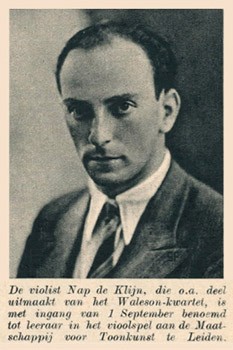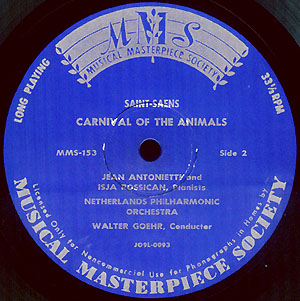|



An
early pre 1925 acoustic recording on the colorful Polydor label:
The Paul Godwin Orchestra plays a potpourri of Franz von Suppé's
Boccaccio (Polydor 60988)


Philips
A 00690 R: Franz Schubert's Forellen Quintet (Trout) performed by
Alice Heksch (Piano), Nap de Klijn (Violin), Paul Godwin (Viola),
Carel van Leeuwen Boomkamp (Cello), and Leon Groen (Bass). Alice
Heksch and Nap de Klijn performed together as "The Amsterdam
Duo" (Das Amsterdamer Duo). Picture taken from Philips S 04012
L.

Paul
Godwin can also be heard in Dvorak's String Quartet reissued on
the Fontana label, and in Mozart's String Quartets K 499 and K 589
on the Philips Minigroove label, reference A00232L.

Paul
Godwin was a member of The Netherlands String Quartet: Nap de Klijn,
violin; Jaap Schröder, second violin; Carel van Leeuwen Boomkamp,
cello. And the quartet became The Amsterdam Quintet when pianist
Alice Heksch joined and after she had died in 1957 was replaced
by George van Renesse. For the performance of the Trout Quintet
(Schubert), the bass player was Leon Groen.
Before
World War Two Nap (Nathan) de Klijn had started playing in a radio
orchestra. Later he became a member of the Waleson Quartet - Dick
Waleson (violin) Nap de Klijn (violin), Giel Smit (alto) and Guillaume
Hesse (violoncello). The photograph below appeared in the Dutch
weekly 'Panorama' in 1936 when it was announced that he was to take
up the post of violin teacher at the 'Maatschappij voor Toonkunst'
in Leiden on September 1st.
 ' '
Nap
de Klijn (1909-1979) was married to pianist Alice Heksch (1936-1957).
Famous are their recordings of several Mozart Sonatas. They are
also admired playing violin gems together under their respective
pseudonyms, Romano Rubato (Nap de Klijn) and Bianca Ritorno (Alice
Heksch), for the Philips label, issued in the 10 inch S-R Series.
The early death of Alice Heksch completely changed Nap de Klijn's
carreer as a performer. In later years he concertised with pianist
Rudolf Jansen. They recorded for the Iramac label. In the 1950s
he was preparing a publication with the title "Technical Studies
for the Left and Right Hand for Violin".

Bert
Robbe (VARA image)
A
few titles of the VARAGRAM 0030 LP: Im Prater blüh'n wieder
die Bäume, La Serenata, Si vous aviez compris, Auf der Heide
blüh'n die letzten Rosen, Chanson de l'adieu.

PPaul
Godwin and his Orchestra and Master Trio
Kleiner
Wiener Marsch - Bretonse Liederen - Guitarre - Petite Marie - Poupéee
Valsante - Tes Jeux - Romanesca - Salut d'amour - Wals - Musette
- Danse Russe - Caprice Viennois - Pizzicato Polka - Kaiser Walzer
- Du alter Stefansturm - 1001 Nacht - Tic-tac Polka
Paul
Godwin, Violin - Jan de Nobel, cello - Gerard Hengeveld, Piano
|
Many
years ago a collector of vinyl records asked me for an LP recording
by violinist Paul Godwin.
Since there was practically no information on the world wide web
at the time, I published a few pictures and details on a page
so he (and others) could read about this violinist who performed
as an altist as well. For the collector it was the info that he
needed on Paul Godwin.
Since then the page about the violinist has evolved to the current
stage it is in.
Paul
Godwin was actually named Pinchas Goldfein. He was born in Sasnowiec,
Poland, on March 28, 1902, and passed away on December 9, 1982,
in Driebergen, the Netherlands.
At
age 10, the talented boy was discovered by Herman Kaplan who was
originally from Latvia. Kaplan jad deserted the Russian army and
had to flee. He took the talented boy with him to Vienna. Kaplan
exploited the young Pinchas who had to pay for the lessons Kaplan
gave him by cleaning the house and doing errands. Paul Godwin
later said : "I've never known a childhood..."
Because
of the changing political and social climate he went to Budapest
and studied with Jen÷ Hubay (1858 - 1937). The bad political climate
after the estab;lishment of the Horthy regime made him leave Hungary
and he finally came to Berlin were he studied at the "Hochschule
für Musik" with Willy Hess (1859-1939).
In
order to pay for his studies young Godwin played in restaurants
and small orchestras in theaters. But the "misuse of one's
own talent by deviating from the serious path" was punished
by the management of the "Hochschule" and Godwin was
expelled. That actually was his first step to success. He became
the leader of the famous "Heller Revue Orchester", he
played in the first radio broadcasts and by 1928 there were already
more than 1500 records of Paul Godwin available on the market
and he was the best selling artist at the time. With his orchestra
he also performed scores for several movies. He toured the country
and was a regular performer in radio broadcasts.
But times changed and in 1933 he took his last 8 Deutsche Mark
and his 1713 Stradivarius violin, fled Germany and came via Luxembourg
to Holland. When in 1940 the Germans occupied the Netherlands,
Godwin was not deported to a concentration camp because his wife
was "Arian" (she died in 1971).
After
the war he played serious music in various ensembles and he founded
ensembles himself.
|
|
|
Paul
Godwin in the late nineteen forties.
Picture
taken from 'Radio Encyclopedie', Amsterdam 1949.
|
From
1946 on he worked for the Dutch Broadcasting Corporation (Nederlandse
Radio Unie, NRU), was violist in the "Alma Musica" ensemble,
and again alto in "The Amsterdam String Quartet" together
with Nap de Klijn (violin), Dick Vos (2nd violin), and Frank Maurits
(cello).
Together with pianist Alice Heksch, violinist Nap de Klijn, violoncellist
Carel van Leeuwen Boomkamp, and bass player Leon Groen, he formed
The Amsterdam Piano Quintet.
He also was a member of "The Netherlands String Quartet"
playing with Nap de Klijn (violin), Jaap Schröder (violin),
Carel van Leeuwen Boomkamp (cello). Lateron George van Renesse
was the pianist in "The Amsterdam Quintet". Hence there
exist two different recordings with Paul Godwin of Schubert's
"Trout Quintet", one with pianist Alice Heksch and another
with George van Renesse; both issued on the Philips label.
In
1955 Paul Godwin started a series of radio broadcasts for Dutch
VARA Broadcasting Association. Mrs. Godwin recorded these transmissions
at home. Before her husband left for the studio, he prepared the
tape machine for recording and when the broadcast started only
the "record button" had to be pressed down. During recording
the level may have been slightly adjusted by Mrs. Godwin. Today
we can still witness the radio performances by Paul Godwin of
small gems by Kreisler, Bloch, Hubay, Wieniawski and others. These
original home made recordings have been marvelously improved and
were released on LP, VARAGRAM 0018.

On
VARAGRAM 0030 Paul Godwin plays with his soloists as he used to
in the 1930s. And this time Dutch singer Bert Robbe who
initially sang classical music can be heard in various songs.
The recording was made at the time when Robbe was director of
the popular music division popular of Dutch radio.
 Isja
Rossišan who is the pianist on VARAGRAM 0018 was born on September
16, 1905, in Vilnius (Vilna, Lithuania). He studied in Vienna,
Berlin and Lausanne and worked for "Radio Berlin". Isja
Rossišan who is the pianist on VARAGRAM 0018 was born on September
16, 1905, in Vilnius (Vilna, Lithuania). He studied in Vienna,
Berlin and Lausanne and worked for "Radio Berlin".

Already
in 1934 Rossican started working for the "Dutch Broadcasting
System" and performed with violinist Eddy Wallis. He later
became a music producer/director for the NRU (Nederlandse Radio
Unie). He was an admired accompanist. He accompanied Kathleen
Ferrier in a recital in the famous Concertgebouw. He had formed
a duo with violinist Paul Godwin until he passed away in 1968.
He can be found on  Musical
Masterpiece Society LP MMS 153, playing one of the pianos
- with Jean Antonietti - playing the other - in 'Carnival of Animals'
(Saint-Saëns) together with the "Netherlands Philharmonic
Orchestra", Walter Goehr conducting.
Musical
Masterpiece Society LP MMS 153, playing one of the pianos
- with Jean Antonietti - playing the other - in 'Carnival of Animals'
(Saint-Saëns) together with the "Netherlands Philharmonic
Orchestra", Walter Goehr conducting.
VARAGRAM
0024 is a modern analog LP recording in stereo of Paul Godwin
and Dutch pianist George van Renesse. Renesse had studied
in Amsterdam with composer Sem Dresden, in Paris with Ricardo
Vi˝ez (1875-1943) and in Berlin with Leonid Kreutzer (1884-1953,
who himself was a studient of Alexander Glazunov). George Van
Renesse was born in 1909, in Zaanslag (Netherlands) and started
an international career. He performed in Rome with Willem Mengelberg,
made numerous tours with the "Budapester Trio" (1930-1945)
and accompanied Yehudi Menuhin during one of his first international
tours (1947). Before and during the war he was a principal teacher
at the "Amsterdam Conservatory" (1930-1945).
|
|
|
Mozart's
Quartet for Oboe, Violin, Viola and Cello K 370: Jaap Stotijn
(oboe), Nap de Klijn, Paul Godwin, Carel van Leeuwen Boomkamp.
Philips 45 RPM: 400 014 A.
|
From
1954 on Van Renesse was producer and recording director for the
"Dutch Broadcasting System" and he had his own radio
programs in which he analyzed and performed compositions by Schubert,
Richard Strauss, Chopin and many others. He also was a marvelous
accompanist admired by violinists and singers alike. He made recordings
for the Artone and CNR labels of music by Schubert (Impromptus)
and Chopin (Waltzes, Nocturnes).
In
quartets, quintets and concertos Godwin is a skillful, serious musician.
In his performances of the pieces of Fritz Kreisler, Godard, Bloch
and so many others, he is also the entertainer and is of course
somewhat less serious. Whatever composition he plays, his style
bears the fruit of a long life of successes on the lighter side
but also shows us the deeper meaning of what music is all about.
The
program on VARAGRAM 0018:
Kroll: Banjo and Fiddle
Bloch: Nigun
Elgar: La capricieuse
Albeniz/Kreisler: Tango
Hubay: Unter Ihrem Fenster (Serenade Op. 38 No. 2)
Kreisler: Tambourin chinois
Kreisler: La Gitana
Mussorgski/Dushkin: Hopak
Ravel/Kreisler: Pièce en forme de Habanera
Fall/Kreisler: Spanish Dance from 'La vida breve'
Burmester: Serenade
Wieniawski: 'Obertas' (mazurka)
The
program on VARAGRAM 0024:
Kreisler:
Liebesfreud, Liebesleid
Tchaikovsky-Flesch: Melodie
Godard: Canzonetta
Bloch: Aboda
Wieniawski: Kuyawiak
d'Ambroise: Canzonetta
Meijrowitz: Wus geven is geven
Massenet: Méditation
Moszkowski-De Sarasate: Gitarre
Kreisler: Schön Rosmarin.
Smetena: Aus meiner Heimat

Sextuor
Instrumental 'ALMA MUSICA' plays Vivaldi on a French 45 RPM Ducretet-Thomson,
470 C 048, from around 1955.

|
